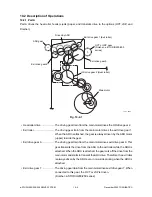
December 2002 TOSHIBA TEC
11 - 3
e-STUDIO160/200/250 DRUM-RELATED SECTION
11.4 Function of Each Part
(1) Drum
The drum comprises a drum-shaped, Aluminum base coated with an organic photosensitive element
(photoconductor) film. The principle of “Photoconductivity” indicates that insulating properties of the
material are evidenced in the dark. Likewise, its conductive properties are evidenced in the presence
of light.
(2) Main charger
Applies a negative electrostatic charge to the drum (through a high-voltage transformer). When high
voltage is applied to this charger wire, the air around the wire is ionized (electrostatically charged).
The ionized air is attracted to the drum’s surface. This phenomenon is referred to as “corona dis-
charged.” In the dark, the surface of the drum is negatively (minus) charged using the principle of
corona discharge.
(3) Discharge LED
Lower the electrical resistance of the photosensitive surface that was left over after the exposure and
transfer processes. The discharge LED has two effects, a cleaning effect and “pre-exposure” effect.
The cleaning effect neutralizes and eliminates the residual charge on the surface of the photosensitive
element while the pre-exposure effect maintains a fixed photosensitive surface potential before the
charging process is again initiated.
(4) Transfer charger
Transfer the toner on the drum to the copy paper. When high voltage is applied to this charger wire, the
air around the wire is ionized (electrostatically charged). The ionized air is attracted to the backside of
the copy paper. This phenomenon is referred to as “corona discharged.” The backside of the copy
paper is positively (plus) charged using the principle of corona discharge.
(5) Paper guide assembly
Positive (plus) bias voltage is applied to the guide to prevent that the of translatability is lowered under
the condition such as high humidity.
(6) Separation charger
Separates the copy paper with toner from the drum. When high voltage is applied to this charger wire,
the air around the wire is ionized (electrostatically charged). The ionized air is attracted to the back-
side of the copy paper. This phenomenon is referred to as “corona discharged.” The backside of the
copy paper is negatively (minus) charged using the principle of corona discharge. The electrostatic
attraction between the paper and the drum weakens.
(7) Vacuum fan motor
Works to help separation of copy paper from the drum surface by sucking the air form the back side of
the paper.
Содержание e-studio 160
Страница 2: ... 2002 TOSHIBA TEC CORPORATION All rights reserved ...
Страница 21: ...e STUDIO160 200 250 OUTLINE OF THE MACHINE 2 8 December 2002 TOSHIBA TEC B 2 Switches SW2 SW1 02 02 04 ...
Страница 140: ...8 PRINTING 8 1 8 1 General Description 8 1 8 2 Structure 8 2 8 3 Laser Diode 8 5 8 4 Disassembly and Replacement 8 6 ...
Страница 222: ...December 2002 TOSHIBA TEC 16 1 e STUDIO160 200 250 PC BOARD 16 BOARD ASSEMBLY 16 1 PWA F MAN 16 01 01 ...
Страница 223: ...e STUDIO160 200 250 PCB BOARD 16 2 December 2002 TOSHIBA TEC 16 2 PWA F RLY 16 02 01 ...
Страница 224: ...December 2002 TOSHIBA TEC 16 3 e STUDIO160 200 250 PC BOARD 16 3 PWA F PIF 16 03 01 ...
Страница 225: ...e STUDIO160 200 250 PCB BOARD 16 4 December 2002 TOSHIBA TEC 16 4 PWA F PNL 16 5 PWA F VR 16 04 01 16 05 01 ...
Страница 226: ...December 2002 TOSHIBA TEC 16 5 e STUDIO160 200 250 PC BOARD 16 6 PWA F SLG 16 06 01 ...
Страница 227: ...e STUDIO160 200 250 PCB BOARD 16 6 December 2002 TOSHIBA TEC 16 7 PWA F FUS ASD AUD CND SAD models 16 07 01 ...
Страница 228: ...17 WIRE HARNESS CONNECTION DIAGRAMS 17 1 ...
Страница 255: ...1 1 KANDA NISHIKI CHO CHIYODA KU TOKYO 101 8842 JAPAN ...
















































